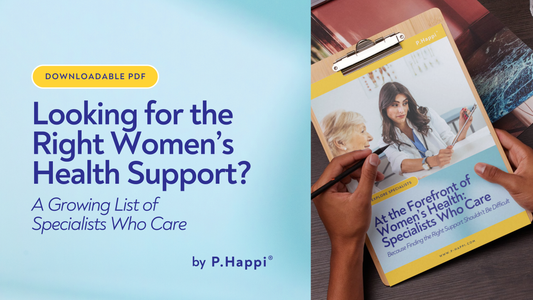
What Does It Mean To Be Microbiome Friendly? With Dr Kristin Neumann Co-Founder MyMicrobiome
MyMicrobiome is an independent body who offer the only registered certification for Microbiome-friendly products in the cosmetics industry. They rigorously test products under strict conditions for the impact on the skin's microbiome. Their certification guarantees that a product respects the balance of the microbiome.
1. What inspired you to start Microbiome-Friendly, and what gap were you hoping to fill in the health and wellness space?
We wanted to close the gap between marketing claims and the scientific evidence behind them. Too many products in health and wellness make bold promises without data to substantiate them. With Microbiome-Friendly, our mission is to provide the missing scientific backbone, ensuring that claims are grounded in real research.
2. What does “microbiome-friendly” mean, and how does it differ from terms like “natural” or “pH neutral” in the women’s intimate care space, as this can be sometimes really confusing for the average user.
At MyMicrobiome, “microbiome-friendly” means that a product has been scientifically tested and proven not to harm the natural balance of the microbiome. Unlike terms such as “natural” or “pH neutral,” which sound appealing but lack measurable standards, our label is backed by rigorous data and defined testing protocols.
3. Can you tell us more about the science behind your testing process? How do you determine whether a product is microbiome-friendly?
We use rigorous in vitro tests, including both single-strain and co-culture systems. In these tests, the most abundant microorganisms of the relevant body area are exposed directly to the product. This setup is deliberately sensitive: if the product causes more than a 30% reduction in microbial growth, it does not qualify as “microbiome-friendly.” Our standard is the strictest in the industry, making it highly reliable, also from a regulatory perspective.
4. What are the key parameters you look at when assessing the impact of a product on the vaginal microbiome?
We use rigorous in vitro tests, including both single-strain and co-culture systems. In these tests, the most abundant microorganisms of the relevant body area are exposed directly to the product. This setup is deliberately sensitive: if the product causes more than a 30% reduction in microbial growth, it does not qualify as “microbiome-friendly.” Our standard is the strictest in the industry, making it highly reliable, also from a regulatory perspective.
5. What does it mean for a brand to carry the Microbiome-Friendly label? How rigorous is the process, and how closely does it replicate real-life conditions?
If a product carries our seal, it has passed the most rigorous test available in the industry. While we do not mimic the mucosal lining of the vagina, our in vitro method is more sensitive than clinical studies, where microorganisms are partially shielded by tissues. In our test system, the bacteria are fully exposed to the product, making the results highly reliable.
6. Why is it so important to protect the vaginal microbiome, and what are the most common disruptors you see in your lab?
The vaginal microbiome is fundamental to women’s health and well-being. Any disruption can have wide-ranging consequences. The most common disruptors we see are intimate washes, fragrances, antibacterial agents, and products with a high pH.
7. What are some misconceptions brands (or consumers) have about intimate care products and vaginal health?
A persistent misconception is that the vagina needs to be “cleaned” with special products. In reality, the vagina is a self-cleansing organ, and washing with water is sufficient. Unfortunately, many intimate washes on the market are still too harsh for this sensitive area.
8. What can I do as a consumer to ensure I buy a proper microbiome-friendly product? If it does not have your seal, what can I look out for?
Avoid products that contain fragrances, essential oils, harsh surfactants, or antibacterial agents. Choose formulations with a pH of around 4–5, which matches the natural environment of the vaginal area. Of course, the safest choice is to look for the Microbiome-Friendly seal.
9. What’s been one of the most surprising things you’ve discovered during your work?
I was surprised by the sheer number of products marketed for intimate care, many of which are actually harmful to the vaginal microbiome. Practices like vaginal douching or steaming, which are still promoted in some places, can be particularly damaging,
10. If you could change one thing about how the industry approaches women’s intimate health, what would it be?
I would reduce the overwhelming number of product categories and shift the focus to health and safety. Every product should be designed with the microbiome in mind, rather than adding to a confusing and often harmful product landscape.
11. What’s next for Microbiome-Friendly?
We are continuously expanding our testing standards to cover additional body areas and product categories, ensuring that more sectors of the health, wellness, and beauty industries can benefit from reliable microbiome safety evaluations. Beyond that, we aim to strengthen collaborations with regulators and industry partners to establish microbiome protection as a gold standard in product development worldwide. Our long-term vision is to make microbiome safety as fundamental and widely recognized as dermatological testing is today.
Dr Kristin Neumann is the Co-Founder and CSO of MyMicrobiome
Dr. Kristin Neumann is a molecular biologist and microbiologist with a PhD focused on understanding how life functions at the molecular level. After working in antibiotic research developing next-generation antibacterial agents, she became increasingly aware of the damaging effects of antibiotics on the human body. Motivated by this insight, she founded MyMicrobiome to raise awareness of the importance of the human microbiome and to promote scientific understanding of how to protect and nurture it. Her work bridges rigorous science and public education, making complex microbiome research accessible to everyone.
For more information on P.Happi's Microbiome Friendly certification visit MyMicrobiome




